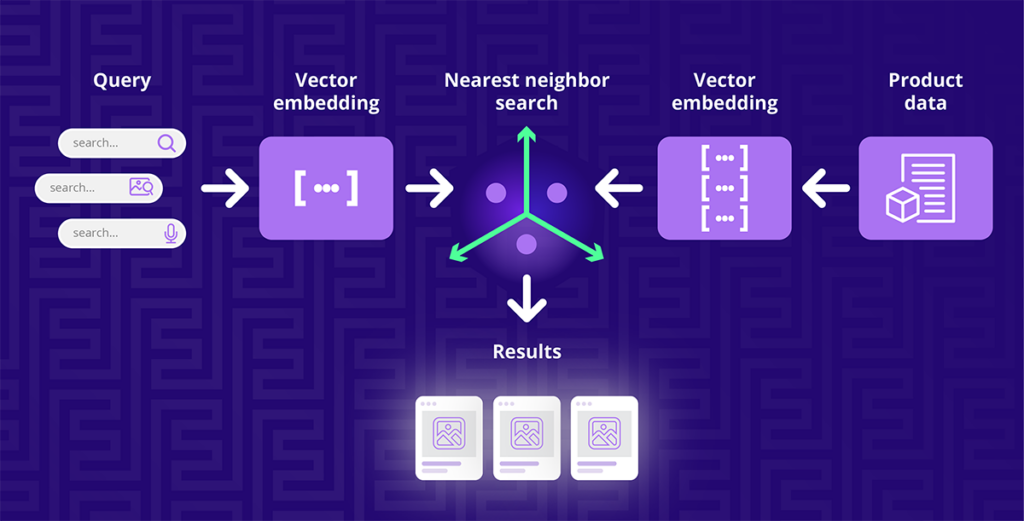41% of online shops have problems with their search function.1 Is vector search the key to higher relevance and fewer drop-offs? Here’s a crash course from an eCommerce perspective.
Definition: what is vector search?
Vector search uses AI to translate complex data, like products, texts and images, into numbers (vectors). It stores this data in a vector database so that when someone searches with an image or another type of complex data, it can quickly find and show similar content based on mathematical distances.
In eCommerce, this technology is used to maximize the relevance of product listings for search results, category pages, recommendations, etc. AI models, like machine learning and natural language processing (NLP), understand the semantic connection between products and search queries, allowing them to deliver relevant results even when there’s no exact match. So, your customers will still see sneakers, whether they search for “kicks” or “trainers”.

Key terms in vector search
- Vector search is a specific method of semantic search that understands context and intent behind queries, even without any matching keywords. It compares shopper input with product data in a multidimensional space using “nearest neighbor search.” While the graphic shows three dimensions, AI models typically use hundreds or even thousands.
- Keyword search in eCommerce looks for similarities between search requests and product data. It’s ideal for query types like brand names, product names and even product IDs, where precision matters. The quality of results depends on the search engine. Basic ones can stumble when a query doesn’t exactly match what’s in the catalog. Smarter systems, like FactFinder’s, use more advanced algorithms to detect not only obvious typos like “sheos” vs. “shoes” but also phonetic similarities like “fone” vs. “phone”. However, even the best keyword search doesn’t actually understand what the user means.
- Hybrid search combines the strengths of keyword search and vector search. The goal is to return relevant hits in every situation, no matter what the customer types into the search bar: SKUs, keywords, mixed language and conversational queries or any mix of these. By intelligently weighting and ranking results, it creates a varied yet highly relevant search experience that meets a wide range of user intents. Resulting in fewer drop-offs, happier customers and a direct boost in revenue per customer.
How does vector search work?
We’ll walk through the workflow with a typical example: intent-based search queries. These queries indicate the reason behind the search. For example, if an online shopper types in “comfortable shoes for a city trip in July,” we can assume they’re looking for shoes suitable for long walks on hard surfaces during summer temperatures. But how does vector search recognize this purchase intent and deliver fitting results? This process consists of three steps:
1. Vector embedding – An AI model translates the words into numeric expressions to capture the meaning behind the query. Now, it can understand that “comfortable” in the context of shoes refers to ergonomically designed, cushioned, lightweight, etc. And from “city trip” and “July,” it extracts, among other things, attributes related to the ground surface and season.
2. Nearest neighbor search – Next, the AI checks these numeric expressions with the product data to semantically similar items based on the mathematical distances in the vector space.
3. Response – The closest products are then returned to the shop as search results. For this search query, these might be breathable, low-cut hiking shoes with arch support.

Use cases: vector search vs. keyword search
Let’s explore different types of search queries to compare the hypothetical performance of a vector search with keyword-based search methods.
In some cases, vector search yields better results; in others, keyword search is more efficient. Our analysis of search queries from over 2,000 shops shows that online customers still mostly do not use natural language inputs — they don’t ask questions like they do in Google, but search with short, precise terms. However, user behavior is changing as we speak, and in the coming years, a reliably functioning vector search could become vital for online retailers.
Use case
Keyword search
Vector search
💡 Intent-based search queries
Processes precise keyword matches.
Understands the context and intent behind search phrases like “casual but elegant office shoes.”
Requires synonym entries like “sofa” = “couch.”
Automatically recognizes semantic similarities without synonym lists.
Advanced algorithms like FactFinder’s Worldmatch® tolerate misspellings, typos, different languages and phonetic deviations like “naikee sneekers.”
Understands similar concepts, regardless of spelling.
Recognizes related products and categories.
🏷️ Brand-specific queries
Ensures only products from the searched brand are displayed.
Recognizes semantic relationships between brands, which could lead to broader results.
Supports precise queries like numerical IDs, key for B2B eCommerce, spare parts vendors and specialist stores.
Finds related products without an exact match, which in some cases, might not be desired.
Searches for exact product attributes like “mattress 180×200.”
Recognizes implicit meanings, e.g., “light laptop for travel.”
Understands queries like “shoes rojo” when it’s a cross-language concept.
Understands the meaning across languages, even with different formulations.
Requires precise inputs. Example: “Shoes for travel.”
Understands complex, natural sentences like ‘Which jackets are best for snow?
Hybrid mode keeps the customer experience in focus
Vector search isn’t always enough on its own, especially when it comes to exact product names, brands or item numbers. Many online shoppers still expect reliable keyword search. That’s why FactFinder blends advanced keyword search with vector capabilities — so you get exact matches when needed, and smart results when keyword search fails.
1. Linguistic matching – The core of our solution is the Worldmatch® search algorithm, which we’ve been refining for over 20 years. The technology detects phonetic similarities between terms and ensures incorrect or imprecise inputs, like “naiki” vs. “Nike,” lead to the correct result.
2. Semantic relevance – Every industry, audience and product range comes with its own unique requirements. That’s why FactFinder’s vector search offers two modes:
- Hybrid mode delivers a smart product list combining keyword-based and vector-based results. You decide which type of result should be weighted higher or lower based on your specific business needs. This mode is ideal for audiences who often browse for inspiration, have limited product knowledge or shop based on specific occasions.
- Fallback mode kicks in only when keyword matching would return no results. Instead of landing on a zero-results page and potentially bouncing, customers see a selection of products that best match the intent and context of their search query.
3. Human expertise – Unlike some search and product discovery platforms, FactFinder is not a “black box.” You can easily track the sorting of your product and recommendation lists in an intuitive backend editor. It’s the perfect blend of automation and control: you can let the AI do the work for you, while having the flexibility to manually adjust the configurations in line with your business goals, e.g., through ranking rules that push selected brands or sale items.
Instead of blindly following the hype around vector search, FactFinder focuses on thoughtful, step-by-step integration. We don’t view new technologies as an end in themselves but concentrate on the experience they bring to users and shoppers. Our solution applies AI to the areas where it creates real value, striking the best balance between keyword precision, semantic context and human expertise.

Conclusion: get the best of both worlds
Vector search offers huge potential to increase conversion rates and AOVs, especially for intent-based search queries, synonyms and natural language inputs. However, it’s not a cure-all. The future lies in hybrid search, a combined approach that blends semantic understanding, keyword precision and AI-powered personalization to show the best results every time.
We’re here to help you address your unique eCommerce challenges. Contact us today to learn more about how our vector search’s hybrid mode can drive sustainable revenue growth.

Interactive demo video
Dive into this interactive demo to explore both the front and the back end of the FactFinder platform and our suite of advanced features. Watch video now